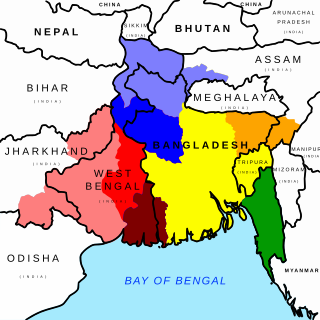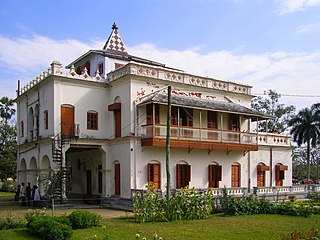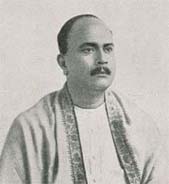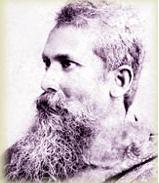
Bengali music comprises a long tradition of religious and secular song-writing over a period of almost a millennium. Composed with lyrics in the Bengali language, Bengali music spans a wide variety of styles.

Rabindra Sangeet, also known as Tagore Songs, are songs from the Indian subcontinent written and composed by the Bengali polymath Rabindranath Tagore, winner of the 1913 Nobel Prize in Literature, the first Indian and also the first non-European to receive such recognition. Tagore was a prolific composer with approximately 2,232 songs to his credit. The songs have distinctive characteristics in the music of Bengal, popular in India and Bangladesh.

The music of West Bengal includes multiple indigenous musical genres such as Baul, Ramprasadi, Bishnupuri Classical, Kirtan, Shyama Sangeet, Rabindra Sangeet, Nazrul Geeti, Dwijendrageeti, Prabhat Samgiita, Agamani-Vijaya, Patua Sangeet, Gambhira, Bhatiali, Bhawaiya, Bengali Rock.

The works of Rabindranath Tagore consist of poems, novels, short stories, dramas, paintings, drawings, and music that Bengali poet and Brahmo philosopher Rabindranath Tagore created over his lifetime.

Rabindranath Tagore was a Bengali poet, writer, playwright, composer, philosopher, social reformer, and painter of the Bengal Renaissance. He reshaped Bengali literature and music as well as Indian art with Contextual Modernism in the late 19th and early 20th centuries. Author of the "profoundly sensitive, fresh and beautiful" poetry of Gitanjali, in 1913 Tagore became the first non-European and the first lyricist to win the Nobel Prize in Literature. Tagore's poetic songs were viewed as spiritual and mercurial; where his elegant prose and magical poetry were widely popular in the Indian subcontinent. He was a fellow of the Royal Asiatic Society. Referred to as "the Bard of Bengal", Tagore was known by the sobriquets Gurudeb, Kobiguru, and Biswokobi.
"Where the mind is without fear" is a poem written by 1913 Nobel laureate Rabindranath Tagore before India's independence. It represents Tagore's vision of a new and awakened India. The original poem was published in 1910 and was included in the 1910 collection Gitanjali and, in Tagore's own translation, in its 1912 English edition. "Where the mind is without fear" is the 35th poem of Gitanjali, and one of Tagore's most anthologised poems.

Suchitra Mitra was an Indian singer, composer, artist exponent of Rabindra Sangeet or the songs of Bengal's poet laureate Rabindranath Tagore, professor, and the first woman Sheriff of Kolkata. As an academic, she remained a professor and the Head of Rabindra Sangeet Department at the Rabindra Bharati University until 1984. Mitra was a playback singer in Bengali films and was associated for many years with the Indian People's Theatre Association.

Jôdi Tor Dak Shune Keu Na Ase Tôbe Ekla Chôlo Re, commonly known as Ekla Chôlo Re, is a Bengali patriotic song written by Rabindranath Tagore in 1905.

Shyama Sangeet is a genre of Bengali devotional songs dedicated to the Hindu goddess Shyama or Kali which is a form of supreme universal mother-goddess Durga or parvati. It is also known as Shaktagiti or Durgastuti.

Dinendranath Tagore, also known as Dinu Thakur, was a Bengali musician, singer and poet.

Vālmīki-Pratibhā is an opera by Rabindranath Tagore. The Bengali libretto was written by Tagore himself based on the legend of Ratnakara the Thug who later became Sage Valmiki and composed Ramayana, a Hindu epic.

Prabháta Saḿgiita, also known as Songs of a New Dawn or Prabhat's Songs, are the collection of songs composed by Prabhat Ranjan Sarkar. Sarkar composed a total of 5,018 songs, including the lyrics and the melody, over a period of eight years from 1982 until his death in 1990. While most songs are in the Bengali language, some are in Hindi, English, Sanskrit, Urdu, Magahi, Maithili and Angika. Prabháta Saḿgiita is also sometimes considered to be a post-Tagore gharana. The poetry of lyrics expresses elements of love, mysticism, devotion, neohumanism and revolution and the songs present a wide spectrum of both Eastern and Western melodic styles.

Atul Prasad Sen was a Bengali composer, lyricist and singer, and also a lawyer, philanthropist, social worker, educationist and writer.

Sangeet Kalpataru is a Bengali language song anthology edited and compiled by Swami Vivekananda and Vaishnav Charan Basak. The book was first published in August or September 1887 from Arya Pustakalaya, Calcutta. In 2000, the book was reprinted by the Ramakrishna Mission Institute of Culture. It was edited with a critical introduction by Dr. Sarbananda Choudhury.

Pratima Devi (1893–1969) was an Indian Bengali artist, widely known for her artistic abilities. She was the wife of Rathindranath Tagore. The poet took special interest in developing her capabilities.
The following is a list of notable people associated withVisva- Bharati University and/or Santiniketan, a neighbourhood in Bolpur city in West Bengal, India:
Sailajaranjan Majumdar was a distinguished exponent and teacher of Rabindra Sangeet.

Sandhya Sangeet is a poetry book written by Rabindranath Tagore in 1882. In English it was translated as Evening Songs. The book was followed by Tagore's another poetry collection Prabhat Sangeet (1883).

Sonar Tori is a collection of Bengali poetry by poet Rabindranath Tagore. The collection has more than forty poems and was first published in 1894. Sonar Tori is considered to be one of the most celebrated literary works of Tagore.

Dwijendranath Tagore was an Indian poet, song composer, philosopher, mathematician and painter. He was one of the pioneers of shorthand and notation in Bengali script. He was the eldest son of Debendranath Tagore and the eldest brother of Rabindranath Tagore.

















